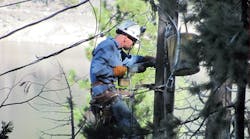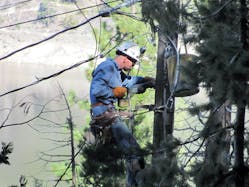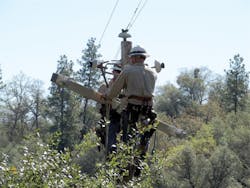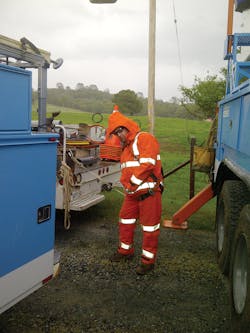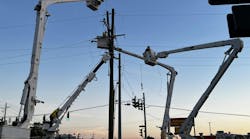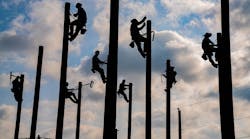Flame-retardant (FR) clothing was once characterized by linemen as stiff, hot and downright uncomfortable. Thanks to advances in technology, however, today’s FR garments are just about as wearable as traditional types of clothing and offer more protection than ever before.
At Pacific Gas and Electric Co. (PG&E), the linemen must wear long-sleeved FR shirts and jeans whether or not they’re working on energized circuits. In the late 1980s and early 1990s, linemen could wear jeans and a long sleeve cotton T-shirt to work in the field. Over time, however, PG&E began changing its requirements. Now, if a lineman doesn’t show up in his FR clothing, he is sent home to change into the appropriate workwear.
Equipping Workers with FR Garments
Each year, PG&E offers its field workers an allotment to replenish their wardrobes with new FR garments. The amount of the allotment depends on whether the employees are working full time or part time in the field and how often they’re working around electricity. For example, workers in the engineering department may receive a smaller allotment than linemen, foremen and apprentices.
Long ago, linemen were limited in terms of the types of FR garments that were out on the market, but now, they can order FR socks, underwear, beanies, fleece-lined gloves and neck gators in addition to the standard garments. To help the linemen find the style that works for them, Riverside Manufacturing Co. visited field offices with an entire wardrobe of clothing in different sizes and styles. Rather than just picking from the catalog, the linemen wereable to try on pants, shirts and jackets before placing their order.
The FR garments are available in a wide variety of colors such as orange, tan, brown and three different shades of blue. The FR shirts also have many different styles from Henleys and button-down shirts to long-sleeved T-shirts. The pants also come in jeans or cotton cargo styles.
All of the FR clothing is customized with the PG&E logo, and in some cases, also with the employee’s name and division. While the allotment can vary from one worker to the next, all employees in the FR program get an allowance each year to spend on clothing. With the typical allotment, a worker usually can get a pair of coveralls, four pairs of pants and four shirts.
Workers can order the type of clothing they prefer. Since PG&E covers a wide service area in the state of California, the weather can vary significantly. For example, if a lineman is in a warmer climate, he or she may order more T-shirts and pants, but if the worker is in an area prone to colder temperatures, he or she may order heavier garments and outerwear.
When PG&E first required its linemen to wear FR clothing about eight years ago, the company showed a video presentation to the field workforce about arc flashes and how FR clothing provided protection. They also educated the linemen on how to take care of the garments to maximize their longevity and durability.
How long the FR garments last depends on how much they are worn and how hard the user is on the clothing. Typically, the garments can last a few years if they are properly taken care of. PG&E’s field workers can launder their FR clothing just like their normal garments. One recommendation, however, is to launder FR garments separately from the rest of their family’s clothing.
Testing FR Outerwear
In addition to wearing the FR garments out in the field, the linemen are now also donning FR rain gear. Back in 2007, the linemen wore off-the-shelf FR rain gear that had just been introduced to the market. During this time period, there a lot of doubt that Gore-Tex FR rain gear would ever be available. While the existing FR outerwear wouldn’t catch on fire, it leaked, and the linemen who wore it would get soaking wet. This became especially problematic for those linemen who worked in cold climates and had to wear wet clothing in frigid temperatures.
In 2010, a few employees were sent by PG&E to attend a three-day safety conference, in which they met a manufacturer that was selling FR clothing. This company wanted to make FR rain gear and later meet with several PG&E employees to design and manufacture FR Gore-Tex rain gear. The outerwear, however, didn’t pass PG&E’s testing procedures. Then the utility met with three other companies based in Europe, Canada and the United States to try to find a manufacturer who could produce Gore-Tex FR rain gear that would meet the utility’s needs. PG&E also formed a rain gear committee of grassroots members and management professionals to evaluate the clothing on the market.
PG&E opted to work with Lac-Mac Ltd. in conjunction with Gore-Tex to create and customize FR outerwear that was geared toward the needs of its electric workforce. While many clothing designers aren’t familiar with how linemen work out in the field, the Canadian manufacturer involved the linemen in the design process from the start.
To serve as a springboard for ideas, PG&E linemen brought all of their ski and outdoor clothing into one room. They then reviewed the features of the garments from a variety of different manufacturers and voiced their opinions about what features they liked and didn’t like about the clothing.
Designing Rain Gear to Fit Linemen
Because linemen work outside in a physically demanding occupation, the manufacturer incorporated product features specific to the needs of linemen. For example, the rain suit had to have zippers in the legs that went up past the knees to make it easy to put on the suit and take it off. When the linemen go out and work, it may not be raining, but if there is a sudden downpour, they don’t want to have to endure the hassle of taking off their boots and then putting them back on. Rather, they want to be able to zip up the legs and slip it on.
Also, the company designed the rain suit with bibs, so they stay up and don’t slide down. That way, if the jacket rides up, it won’t expose the undergarments to the weather. The suit also has adjustable suspenders that are crossed in back and sewn together so they won’t slide down over the user’s shoulders.
The jacket is shorter than a normal jacket so the linemen can wear their tool belts and not have their jackets overlapping their belts. It also has longer sleeves so if they are reaching out above their head or hot sticking, it still provides protection. If it had regular-sized sleeves, then they would be too short when the linemen extended their arms. The jacket features a larger hood, so it can fit over a hard hat without restricting head movement. At PG&E, the field workforce mostly wears large bucket-style hard hats, so they needed to have an especially large hood.
The inside of the jacket, which zips in front of the face, is made from a fleece material so the user’s face doesn’t get rubbed raw during extended wearing periods. It also features fleece around the neck and chin. The double-zipper jacket also has a flap over the zipper, a drawstring waist and a fleece-lined pocket and zip pocket where they can stick their hand inside to keep it dry. An intercuff on the sleeve also keeps the water from running down the wearer’s arm. Velcro cinch straps around the ankles allow the person to pull them in tight for extra protection or have them loose for added comfort. In the future, PG&E will work with the manufacturers to make any needed changes.
Another important consideration was the sizing of the garments. The height and size of the linemen can vary widely, so the manufacturer offers the suits in standard sizes (small, medium and large) as well as with long sleeves and legs.
So far, PG&E has distributed about 500 of the rain suits out to the field workforce, and in the future, about 2,000 of the field workers will be wearing the outerwear. The suits help the linemen to stay safe and dry out in the field, whether they’re working in mild or cool temperatures. By providing its linemen with FR clothing, PG&E is able to protect its workers from arc flashes and enhance its safety program.
Editor’s note: Jeff Rhinehart, an electric crew foreman with PG&E in Sonora, California, contributed to this article. Rhinehart is responsible for running day-to-day jobs, focusing on safety, and working with the construction and maintenance group.
